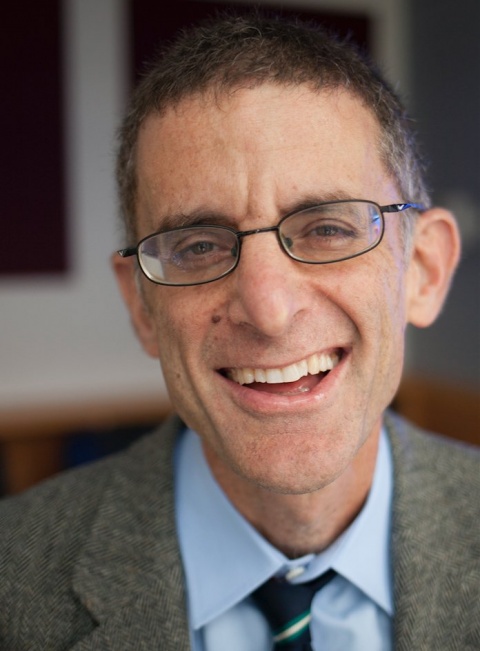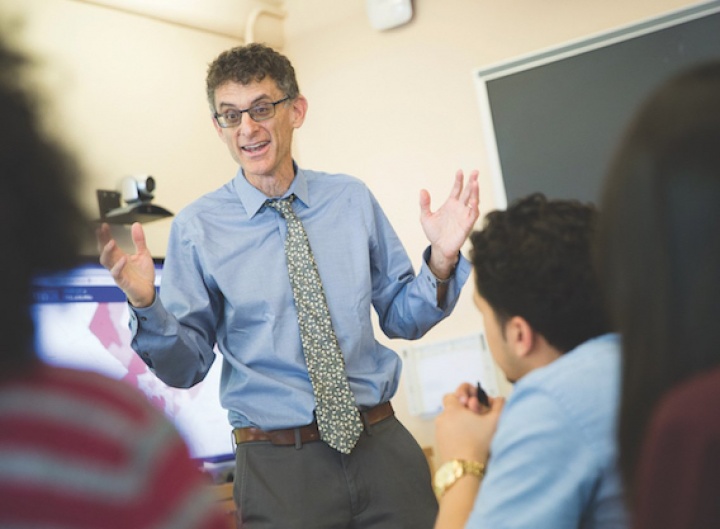Columbia College | Columbia University in the City of New York
How Can Higher Education Aim Higher?
Amid the many controversies and pressures facing American colleges today — political, cultural, curricular, financial and epidemiological — it is good to return to first principles and remember that the heart of the enterprise is, and always has been, teachers imparting knowledge and skills to students. Or attempting to, with wildly varying degrees of training, supervision and success.

Jonathan Zimmerman ’83
“College teaching is the only profession which does not require its members to prepare for their life’s work,” Zimmerman writes in his 2020 book, The Amateur Hour: A History of College Teaching in America, quoting a fellow academic. Says Zimmerman, “Our scholarship is a professional enterprise, resting on peer review and other long-standing collective practices. But when it comes to teaching, we’re solo operators. We’re flying by the seat of our pants.”
Zimmerman brings decades of research and experience to the subject. A native of Washington, D.C., he majored in urban studies at the College, where he was editor-in-chief of Spectator and graduated summa cum laude. After 20 years teaching at NYU, he joined the Penn faculty in 2016. He has published nine books — most recently Free Speech, and Why You Should Give a Damn (with Signe Wilkinson) — and is a prolific contributor to academic journals, as well as The Washington Post, The New York Review of Books and other publications. In 2008, Zimmerman received NYU’s Distinguished Teaching Award. “It was — and remains — my proudest moment as a professor,” he says.
CCT reached Zimmerman at home in Philadelphia, where he lives with his wife, Dr. Susan Coffin; they have two daughters, Sarah ’15 and Rebecca. Here are edited excerpts of the conversation, which explored why teaching has been undervalued in the modern university, and what might be done about it.
CCT: Let’s begin with some context. Your book points to a greatly changed landscape of higher education, and to the growing chasm between elite colleges and the majority of other schools. Does college teaching face the same challenges across the board?
Zimmerman: There are some 4,700 degree-granting institutions of higher education in the United States, enrolling millions of students. It’s an unbelievably diverse landscape, and most of it looks nothing like the traditional, four-year liberal arts colleges where students generally enter at 17 or 18. Half of the country’s undergrads are community college students. A quarter of them are 25 or older. A quarter of them have children. The average completion time is between six and seven years. And the majority don’t major in the liberal arts. The biggest undergraduate major in the U.S. is business, by a country mile.
What this means instructionally, because resources are so unevenly distributed, is that the rich get richer and the poor get poorer. The more elite your school is, the more likely it is that you are going to have a small class or small seminar. By the same token, the less privilege you have, the more likely it is you’re going to be in highly impersonal environments, with either giant classes or, more likely, online ones. Both teaching and learning tend to suffer.
But even in the top schools, teaching has been devalued to a large extent. There is a great reliance on adjuncts, part-time instructors and grad student teaching assistants to staff courses and sections. This is not automatically terrible for either students or teachers — even the most celebrated professors must begin somewhere — but the lack of mentoring, supervision and evaluation of lower-level teachers is a real problem.
CCT: Ineffective, impersonal teaching is not a new phenomenon, your research shows. People have been concerned about the quality of college teaching since the 19th century. What has been the main complaint?

Professor Zimmerman in action at Penn.
CCT: Listening to Burgess drone on must have been torture. But in today’s university, it is not inspired classroom teaching that advances a teacher’s career. You say that even Socrates would not be hired, let alone granted tenure today — his application would be stamped, “Insufficient scholarly production.”
The heart of the problem has always been the tension between scholarship and teaching — that is, between the creation of knowledge and the sharing of it. I don’t think that tension is inherent in these functions. Alumni rightfully point to great teachers who are also brilliant scholars — a good example is Columbia historian Eric Foner [’63, GSAS’69]. I think it’s a tension that came about for institutional reasons, beginning in about 1890, with the rise of the modern university. As knowledge became vastly more complex, universities hired specialists who had devoted themselves to relatively narrow areas of study; whether these scholars could teach about their specialties — or anything else — became a secondary question, if it was asked at all. And now the question is, do we want to resolve that tension?
The heart of the problem has always been the tension between scholarship and teaching — between the creation of knowledge and the sharing of it.
CCT: Your book zeroes in on the 1960s and ’70s as a watershed era of turmoil and change in college teaching. Could you dive into that transitional period a little bit?
Zimmerman: It was a time of profound change in higher education. The college-age population was booming. Far greater numbers of women and African Americans were enrolling. Under Lyndon Johnson’s leadership, the federal government was pouring resources into student aid and university research and facilities. Undergraduate enrollment grew from 3 million in 1960 to 10 million in 1973. There was a point when a new community college was opening every three days. Before WWII, no university in America had more than 15,000 students. By the end of the ’60s, there were 50 institutions of that size, and eight were more than twice that size. So an institution that had formerly served a pretty small slice of Americans became a truly immense enterprise in the ’60s and ’70s.
CCT: The tempo of change was rapid, and it was reflected in student attitudes.
Zimmerman: Exactly. At the same time that the university is getting gigantic, it also becomes a focal point of political and social protest. We tend to forget, however, that those same protesters were also challenging the assembly-line ways universities were teaching them. It was the old theme of impersonality, of alienation, multiplied by 100 or 1,000. At the University of Minnesota, the introductory psychology course crammed 2,000 students into an amphitheater. That’s like going to class at Carnegie Hall. American college students were condemning the mass class, and in general, the kind of mechanical, impersonal and inadequate instruction they got. I think it’s both interesting and depressing that while there’s plenty of protest on campuses today, there is almost none about this.
CCT: Great teachers emerge, of course, but they are not generally rewarded with career advancement or higher salaries for the time, dedication and skill they devote to teaching. Have there been efforts to reverse this tide?
Zimmerman: Reforms have been tried, and we should keep trying. In recent years there has been a lot more knowledge generated about good teaching. There have been some promising organizational efforts to address this issue. The Association of College and University Educators is bringing people together from all over the country, trying not just to provide more information and training and instruction around education, but also — and this is the heavy lift — to change the incentives, to create more tangible rewards for teaching as well as scholarship. That will take a very, very long time.
CCT: In The Amateur Hour, you point to peer review as an important concept that can be applied more broadly to teaching as well as research.
Peer evaluation is hard to do well. But if in fact we want to change the equation and include effective teaching as a more important element in determining faculty hiring, compensation and promotion, the only way that’s going to happen is if we judge each other, as we do on the research front. We should be judged by fellow professionals, not just by our students. Let me be clear, I’m a supporter of student evaluations. They can tell us important things: Does the professor return work in a timely fashion? Does the professor make an effort to be available outside of class? Those things matter. But the students can’t judge very well whether this an academically valid or strong class, any more than I could go into a physics class and tell you if it’s an academically sound class. I think only physicists can tell you that.
CCT: Do you find that your colleagues in academe are open to these kinds of changes?
Zimmerman: Occasionally when I rant like this to a colleague, they’ll say, look, we could never figure out who’s a good teacher because that’s just impossible to measure. And frankly, I think that’s a hollow argument. Institutions that have generated Nobel Prizes in studying the most complicated aspects of human behavior could apply those skills to this problem. Of course they could. But this isn’t really an intellectual problem. It’s a political one, in the sense that we don’t have the will and the consensus to devote ourselves to burrowing in on this problem. If we wanted to, we could. We have the skills, we have the knowledge. What we don’t have yet is the will.
CCT: Who was your own most memorable or influential teacher at Columbia?
Zimmerman: Eviatar Zerubavel, a sociologist, was fantastic. He taught with rigor and imagination, as if what he was communicating was the coolest thing ever conceived. I’m not sure you can teach that quality to teachers, but I do know, because I experienced it, how inspiring it is.
Former CCT editor Jamie Katz ’72, BUS’80 has held senior editorial positions at People, Vibe and Latina magazines and contributes to Smithsonian Magazine and other publications. His most recent CCT pieces are the Online Exclusive “Alice Neel’s Columbia Paintings,” and “Thomas J. Vinciguerra ’85: Inimitable Writer, Colleague and Friend” in the Spring/Summer 2021 issue.

